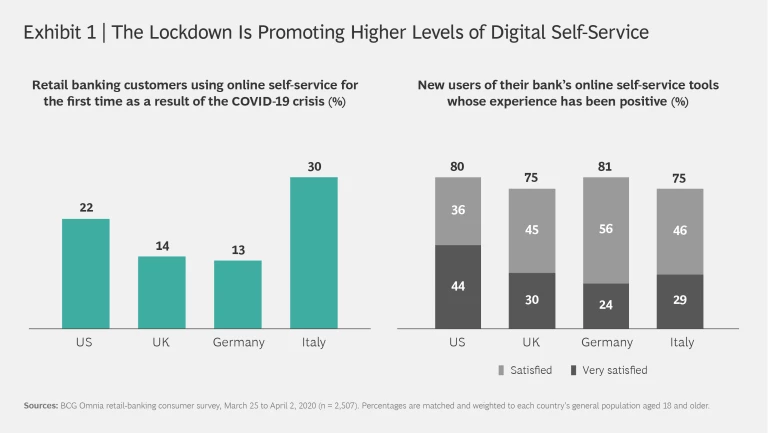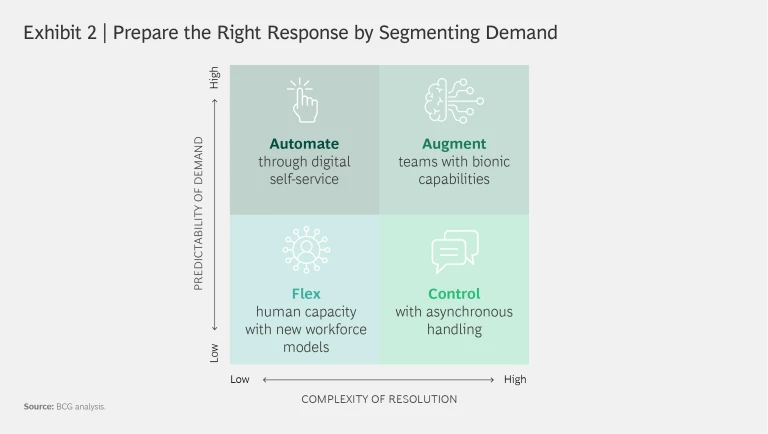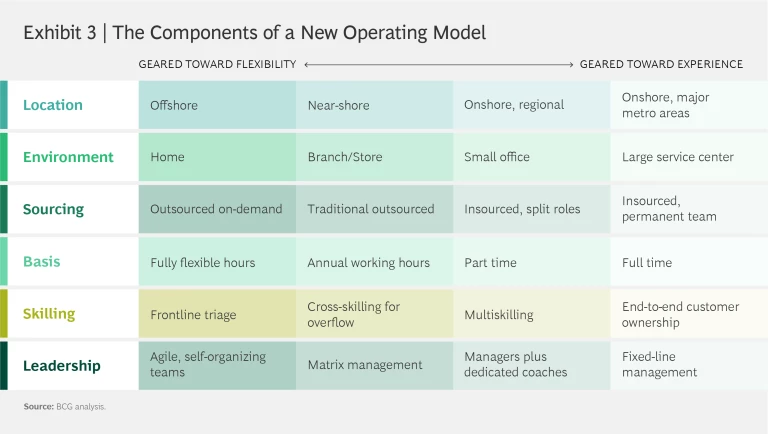For customer service leaders, the maxim “never let a crisis go to waste” should resonate more strongly than ever. The COVID-19 outbreak has triggered abrupt changes in the circumstances and behaviors of consumers, employees, and businesses. The urgency and severity of the situation have forced leaders to find ways to overcome huge operational challenges, such as the logistical, technical, and security constraints that result when most of the customer service workforce is doing its job from home. Those who have stabilized their contact center operations with effective crisis management have completed an essential first step. Now they must think about how to harness the positive forces of change unleashed by the crisis.
As leaders shift their focus to the longer term, they should recognize that the pandemic has imposed fundamental changes in the ways that customers access service and in the ways that organizations set themselves up to deliver. Many of these changes don’t reflect new ideas but rather have been accelerated by the physical constraints arising from lockdown rules. Companies have an opportunity to build on this momentum to improve resilience and find advantage in the new reality of the postcrisis world.
A Catalyst for Positive Change
From the customer’s perspective, the closing of physical stores and branches has driven a step change in the use of remote service channels. In the US, calls to contact centers from banking customers have increased by 14%. And these customers’ use of web and app self-service tools has increased by 20%. In fact, since the crisis began, 22% of US consumers have used their bank’s online self-service tools for the first time, and 80% of them have had a positive experience. (See Exhibit 1.) Companies have been trying to persuade customers to use digital self-service for at least the past ten years, with mixed success. Now it is being adopted at unprecedented rates.
Internally, companies are rapidly making decisions about issues that may have languished on the agenda for months or even years. Cross-functional crisis teams have been able to make decisive choices because their leaders are working together to achieve common, and often ambitious, goals. For example, one company built, staffed, and fully operationalized a 650-seat virtual contact center in ten days. Even in this logistically challenging environment, large business process outsourcing companies in India are now running operations with between 60% and 90% of the workforce logging in from home. Such radical shifts may be only the tip of the iceberg when it comes to the possibilities for more flexible, remote working, enabled by scalable cloud infrastructure and innovative approaches to leadership.
In many cases, a company can build on this momentum to develop a more responsive, stable, and effective operation. But it is not enough simply to continue in crisis management mode, reacting to each unforeseen challenge. Customer service leaders need to plan and build fundamentally more resilient, dynamic operations in order to navigate the challenges of the new reality and pursue competitive advantages in the recovery when it comes.
To position customer service operations and contact centers for the future, we believe that leaders must find the time and management bandwidth to focus on three imperatives: embedding structural resilience, switching to a more responsive and flexible operating model, and preparing to lead in the recovery.
Embed Structural Resilience
Traditional business continuity plans are being tested to their limits by the COVID-19 crisis response, with backup operations often unable to function effectively under lockdown conditions. In the face of ongoing uncertainty, leaders need the ability to deploy capabilities dynamically in response to supply constraints and unpredictable shifts in demand.
The solution is to embed structural resilience as a permanent feature of new ways of working. This requires that companies understand the nature of potential customer service requests along two dimensions: the predictability of demand and the complexity of resolution. (See Exhibit 2.)
- The predictability of demand will determine capacity requirements.
- The complexity of resolution will determine the skill level required and the potential for automation.
For predictable, low-complexity requests, automate through digital self-service. Companies should seize the opportunity to promote a sustainable shift to digital self-service channels. An increase in self-service for high-volume, transactional requests—such as paying bills, explaining product features, or checking account balances—will free up human capacity for more complex and sensitive requests.
To encourage digital sign-up, many companies are conducting targeted marketing campaigns (through email, SMS texts, and recorded messages while callers are on hold with the contact center). As lockdown restrictions are eased, companies should follow up with a sustained marketing push—promoting the speed, ease of use, and security benefits of self-service. Customers respond best to thoughtful communications that emphasize how people can play their part in easing staffing burdens and ensuring that high-priority cases receive prompt attention.
This is also an opportunity for the entire company to adopt a bolder “digital first” mindset, building products and services that can only be accessed online. Digital-only insurance policies, telephone plans, and bank accounts have existed for a while; now is the time to offer them to a mass-market customer base rather than just to niche customer segments.
For predictable, high-complexity requests, augment teams with bionic capabilities. Contacts not handled through digital self-service are likely to involve customers who are coping with financial or emotional challenges. To handle these effectively, customer service representatives need a degree of sensitivity and empathy. Companies can free up their attention for these difficult interactions by minimizing the amount of time that they spend wrestling with multiple IT systems and searching for information. According to BCG’s research, 45% of call time is “dead air” (while the representative searches for information, while the caller is on hold, or while the caller waits to be transferred). This suggests that systems and processes are preventing representatives from providing high-quality service.
To reduce complexity for representatives, companies can deploy bionic tools that seamlessly integrate human and digital support. These tools use natural language processing to understand the customer’s intent and implement the right solutions. They can help with:
- Knowledge: providing relevant answers based on context
- Process: automating repeatable tasks, such as data entry into multiple systems
- Quality and performance: providing real-time guidance and coaching
In the face of ongoing uncertainty, leaders need the ability to deploy capabilities dynamically in response to supply constraints and unpredictable shifts in demand.
For example, companies report that by implementing AI-driven knowledge base tools, they have improved first-contact resolution by five to seven percentage points, reduced handling time by 20% to 30%, and reduced new-hire training time by 25% to 40%. These improvements contribute to better customer satisfaction as well as enabling a more nimble workforce that is ready to respond to less predictable demands.
Bionic operations are relevant not just to the frontline. Organizations that invested heavily in automation of middle- and back-office functions have had an advantage in handling lockdown conditions, because they rely less on large interdependent operations teams to run processes.
End-to-end digitization of customer support processes will drive efficiency savings and, more important, contribute to resilience. For example, a global bank that invested in middle- and back-office automation has been better able than its competitors to maintain stable operations during the lockdown. The bank’s leaders are free to focus on long-term steering, instead of scrambling to find the needed resources.
For unpredictable, low-complexity requests, flex human capacity with new workforce models. A key requirement for responding to volatility is the ability to deploy resources more flexibly. To a great extent, this depends on partially shifting away from the traditional model of contact centers, which rely on employees commuting to large-scale, densely populated “human factories” for eight-hour shifts, five days a week. In the future, a flexible workforce will operate from a variety of locations: contact centers, regional offices, branches, and homes.
The virtual contact center model is not new, and for most organizations it has become the short-term norm during the crisis. Compelled by the need to maintain operations, many companies have rapidly addressed challenges relating to information security, network stability, employee engagement, performance management, and support for remote leaders. They should now be seeking to embed these ways of working into a more sustainable model.
The solution is to embed structural resilience as a permanent feature of new ways of working.
Remote working has many potential benefits: companies report better employee retention, more flexible shift rostering, and the ability to source talent from a broader pool. When implemented at scale, it can also lead to lower facilities costs. At one North American airline, 95% of contact center employees work from home. Team members can work flexible shifts that last from 15 minutes to 8 hours. Supervisors have a full set of quality monitoring, coaching, and communication tools for managing staff remotely. And all employees live within a 90-minute drive of a service center, to which they travel once a month for training and motivation.
The shift to a remote model is unlikely to spell the end of physical contact centers, however. Remote workers—especially those working part-time or on flextime—may not be able to accumulate enough experience to handle more complex requests, and the infrastructure, security, and management challenges of this model will not suit all processes and teams. While remote working may be appropriate for experienced customer service reps, new employees may benefit from onsite training and coaching to develop their skills.
For unpredictable, high-complexity requests, control with asynchronous handling. Unpredictable problems that require specialist skills—such as debt refinancing for small businesses—are the most challenging to prepare for. Such issues cannot be handled effectively by flexible part-time or temporary workers, who generally lack the requisite training and experience.
In an approach that has been successfully deployed by many health care systems to cope with COVID-related demand surges, a frontline team of flexible workers interacts with customers in real time, performing basic triage and prioritizing cases. This team is supported by a second-line team of more experienced staff that handles the most complex cases offline. As adoption of digital self-service grows, the frontline workers can be trained to handle more complex tasks without the need to hand off tickets to their offline colleagues.
Many aspects of technology, workforce acquisition, leadership, and service-level management can be designed to support increased or reduced capacity on short notice. An Asia-Pacific airline, for example, has developed protocols to repurpose resources in the event that adverse events such as bad weather affect operations. This allows the carrier to better accommodate its frequent-flyer passengers. Bionic tools that utilize dynamic AI models can likewise facilitate rapid decision making. A Northern European airline has adopted AI-driven tools to help reschedule flight attendants, pilots, and passengers dynamically; these models can help handle unpredictable demand as well.
Switch to a More Responsive and Flexible Operating Model
Companies need a cohesive operating model to handle the full range of possible demand in customer service operations. They must carefully select from and combine a variety of options in order to balance the flexibility needed to handle uncertainty with the experience needed to handle complexity. (See Exhibit 3.)
To ensure that teams are set up for success, companies should consider the following:
- Reinvigorated leadership styles to steer and motivate more dispersed teams
- Dynamic workforce management to ensure that resources are deployed effectively to meet upcoming demand
- Benefits and incentives to match the responsibilities and expectations of each group
- Virtualized infrastructure to allow incoming contacts to be distributed across many locations
- Upgraded tools that support distributed working, such as learning management, coaching, and quality assurance tools that do not rely on face-to-face interaction
- Analytics and insights that enable ongoing adjustment of the model to meet service goals
- Teams empowered to identify and implement further opportunities for improvement
Be Prepared to Lead in the Recovery
As life settles into the new reality, there will be a pressing need for companies to return to precrisis performance by rebuilding sales and customer relationships. It will be an extended period before physical branches and stores can fully resume operations, creating a role for contact centers as a human-supported channel to drive the recovery. We do not know the timing and rate of this recovery or whether any subsequent lockdowns may delay progress. Even so, there are measures that customer service leaders can set in motion now.
Support the growth of e-commerce. For consumers who are staying at home, digital has become the default way to buy essential goods and services. But many are first-time users who need help navigating the technology. Human-supported digital journeys have a higher success rate. For example, one retailer found that proactive web chats increased shopping-basket conversion threefold when combined with accurate targeting.
Companies need a cohesive operating model to handle the full range of possible demand in customer service operations.
Representatives need to be equipped with the right tools (such as co-browsing) and training in order to guide customers toward completion. Over time, these activities will permanently change consumer habits and preferences. One European luxury-goods brand saw e-commerce sales value increase by more than 400% after it launched a proactive live chat and co-browsing capability to augment web sales.
Develop service-to-sales capabilities. In service sectors like telecom, customer service teams already serve as a sales channel, offering targeted upgrades and new products as part of the customer service interaction. In the post-lockdown world, these interactions (numbering in the thousands or even millions) can be a valuable sales opportunity.
Personalization is the key to success. The most mature companies provide highly targeted offers and route customers to representatives according to the likelihood that they will purchase specific products. For example, a European telco achieved a threefold increase in sales through the contact center by utilizing personalized offers and dynamic steering of customers to trained “service to sales” teams based on the reason for the initial contact.
Refine tone of voice. As life begins returning to normal, brands will need to win back customers by showing great integrity, transparency, and empathy. Highly scripted customer service interactions risk appearing tone-deaf and may even do reputational damage.
It may be helpful to think of customer service as a highly personal marketing channel. To create the right impression with customers, it’s important to assess and revise how policies, incentives, leadership styles, recruitment, training, and coaching programs contribute to tone of voice. A European energy utility, for example, saw an improvement in its net-promoter score after training representatives to engage with customers as though they were family members in need of help.
The past few months have been a difficult period for customer service leaders as they try to manage the disruptions caused by the initial wave of the pandemic. They have responded to huge stresses on their operations with long hours and incredible ingenuity and dedication. In the future, the role of the leader will be more important than ever. Success requires being comfortable with uncertainty, mastering complex customer requirements, and, most important, showing compassion for co-workers and customers who are all facing their own particular challenges.
Now is the time to start planning ahead for the long term. By actively seeking advantage in the new reality, customer service leaders can help their companies not only survive through the darkest days of the crisis but also to thrive in the post-COVID world.












